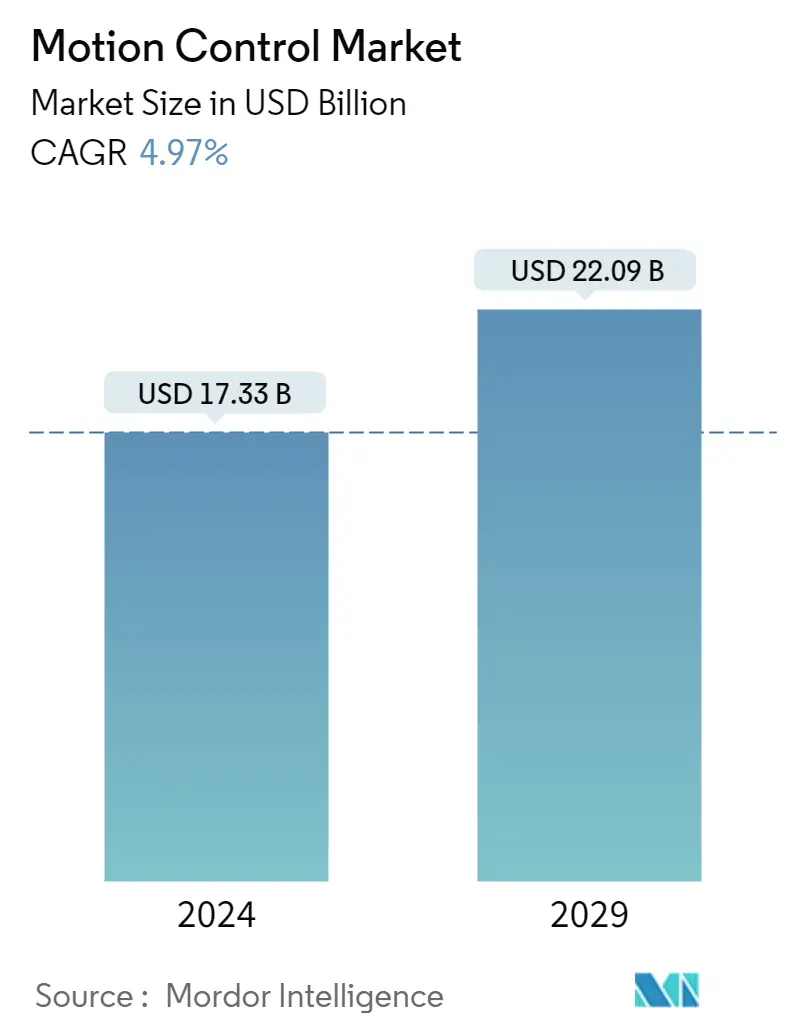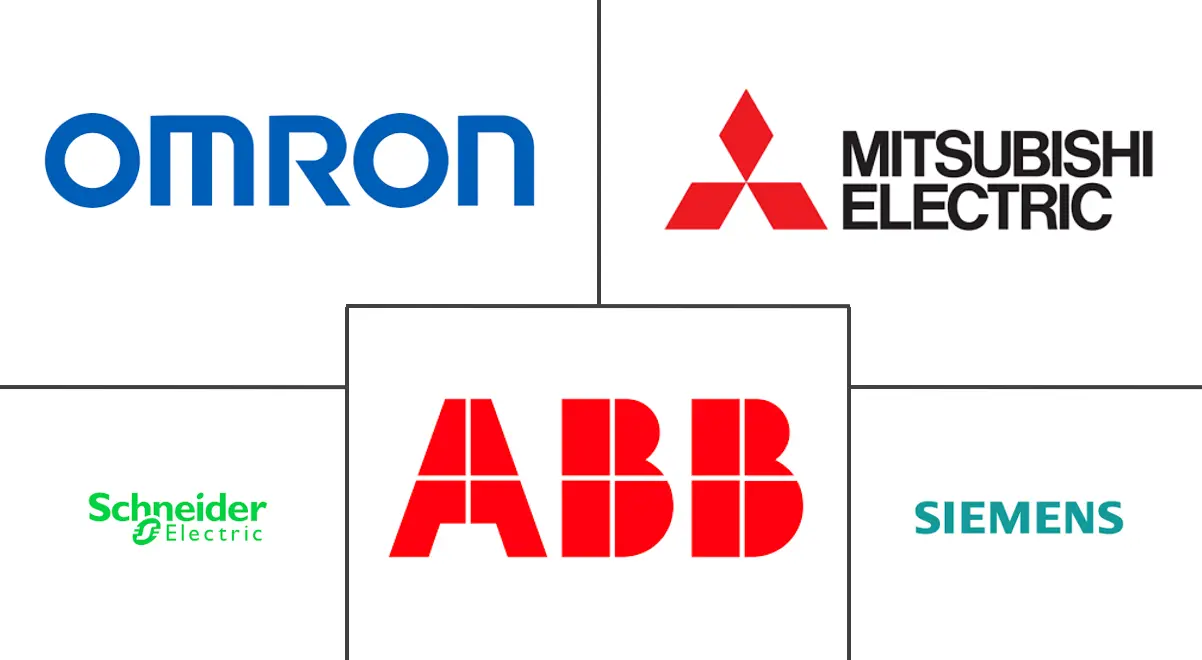Market Size of Motion Control Industry

| Study Period | 2019 - 2029 |
| Market Size (2024) | USD 17.33 Billion |
| Market Size (2029) | USD 22.09 Billion |
| CAGR (2024 - 2029) | 4.97 % |
| Fastest Growing Market | Asia-Pacific |
| Largest Market | Asia-Pacific |
| Market Concentration | Low |
Major Players
*Disclaimer: Major Players sorted in no particular order |
Motion Control Market Analysis
The Motion Control Market size is estimated at USD 17.33 billion in 2024, and is expected to reach USD 22.09 billion by 2029, growing at a CAGR of 4.97% during the forecast period (2024-2029).
The increasing adoption of Industrial IoT (IIoT) and the growing number of smart factories are further expanding the growth of the market studied. Smart factories are becoming significant adopters of motion control products. The industrial IoT further increased the need and demand for connected machines in industries. These connected machines alone are not enough to accomplish pure digital transformation; organizations are developing a seamless ecosystem of humans and machines, performing optimized, end-to-end processes.
- Governments across the globe have enacted various policies supporting automation to improve energy efficiency while significantly reducing the costs incurred. For instance, the Malaysian government launched a National Policy on Industry 4.0 (Industry4WRD). A budget of over USD 1.2 billion was allocated to help businesses adopt Industry 4.0. Within the allocated budget, a total of USD 720 million was allocated to boost the adoption of smart technologies such as robotics, automation and artificial intelligence (AI) under the name Industry Digitalization Transformation Fund. About USD 480 million was allocated under the Business Loan Guarantee Scheme (SJPP) for SMEs planning to invest in automation and modernization.
- Additionally, the increasing trend of warehouse automation and growth in trends, such as digital twins, edge computing, and predictive manufacturing, is also developing space for advanced motion control devices. Robots have become a significant automation trend across the world. In advanced automotive manufacturing, robots have become an essential component. Companies like Amazon are also heavily increasing, and robots, like collaborative robots and AGVs, are becoming the center of attraction in the manufacturing industry.
- Also, in January 2021, The Information Technology Industry Development Agency (ITIDA), through the 'Egypt Makes Electronics' EME Initiative, launched the Industry 4.0 Implementation program in cooperation with Industry 4.0 service provider Fraunhofer IPK Germany aiming at transforming traditional mechanisms and standard practices of manufacturing electronics and home appliances to industry 4.0 techniques and methods, to bring about a qualitative transformation in the industry and to keep up with the international competition. These initiatives are also boosting g the studied market.
- In May 2021, Performance Motion Devices, Inc. (PMD), a provider of motion control ICs, modules, and boards, announced the availability of ION/CME N-Series Digital Drives, new members of the ION Digital Drive family that provide high-performance motion control, network connectivity and amplification. N-Series ION digital drives feature a patented, ultra-rugged PCB-mountable package with three power output levels - 75, 300, and 1,000 watts. All ION/CME N-Series Digital Drives support Brushless DC, DC Brush, and step motors.
- Further, the outbreak of the COVID-19 pandemic has necessitated the implementation of automation, digitalization, and AI, in the manufacturing sector as these are proven to improve resilience to future pandemics. Due to the disruptions in the supply chain and the suspension of manufacturing activities attributed to social distancing norms, several industry players are looking for different solutions to avoid such situations in the future. Adopting automation and robotics in such a situation can reduce dependence on human labor, increase productivity, and reduce the chances of plant shutdowns. Adopting automation and other technologies, such as digitization and AI, will help industries continue their production without the need for human supervision.
- Moreover, the COVID-19 pandemic has created economic turmoil for small, medium, and large-scale industries worldwide. Additionally, the previous country-wide lockdown has drilled many manufacturing industries. This has fluctuated the demand for motion control devices across some sectors.
Motion Control Industry Segmentation
A motion controller contains motion profiles and target positions that create trajectories for motors and actuators. Motion control drives are a structural part of motion controllers. The scope of the study tracks the revenue accrued from the sale of various types of motion control devices that are used by different end-user industries in multiple geographies. Due to the advancement in processing speed, precision, and reliability of these systems, the controllers are widely used in industries. Further, the study also covers the impact of COVID-19 on the market.
| Product Type | |
| Motors | |
| Drives | |
| Position Controls | |
| Actuators & Mechanical Systems | |
| Sensors and Feedback Devices |
| End-user Industry | |
| Electronics & Semiconductor | |
| Pharmaceutical/Life Sciences/Medical Devices | |
| Oil & Gas | |
| Metal & Mining | |
| Food & Beverage | |
| Other End-user Industries |
| Geography | |
| North America | |
| Europe | |
| Asia Pacific | |
| Latin America | |
| Middle East and Africa |
Motion Control Market Size Summary
The motion control market is poised for significant growth, driven by the increasing adoption of Industrial IoT and the rise of smart factories. These developments are fostering a demand for connected machines, which are integral to achieving digital transformation in industries. Governments worldwide are supporting automation through policies aimed at enhancing energy efficiency and reducing operational costs. Initiatives like Malaysia's National Policy on Industry 4.0 and Egypt's Industry 4.0 Implementation program are examples of efforts to boost the adoption of smart technologies. The trend towards warehouse automation and the integration of advanced technologies such as digital twins and predictive manufacturing are further propelling the market. The COVID-19 pandemic has accelerated the need for automation and digitalization, as industries seek to improve resilience and reduce reliance on human labor.
The oil and gas industry is also witnessing a surge in the adoption of motion control systems, driven by the need for energy efficiency and cost-effective operations. The sector is increasingly investing in predictive maintenance to reduce capital expenditures, with companies like ADNOC and IndianOil leading the way in implementing advanced motion control solutions. The Asia-Pacific region, particularly China and India, is emerging as a key market due to its focus on automation and renewable energy initiatives. The region's manufacturing hubs are rapidly adopting industrial automation, with China aiming to become a global leader in robotics by 2025. Major players in the motion control market are expanding their presence through strategic collaborations and product innovations, further enhancing their market share and profitability.
Motion Control Market Size - Table of Contents
-
1. MARKET INSIGHTS
-
1.1 Market Overview
-
1.2 Industry Attractiveness - Porter's Five Forces Analysis
-
1.2.1 Bargaining Power of Suppliers
-
1.2.2 Bargaining Power of Consumers
-
1.2.3 Threat of New Entrants
-
1.2.4 Intensity of Competitive Rivalry
-
1.2.5 Threat of Substitutes
-
-
1.3 Industry Value Chain Analysis
-
1.4 Technological Advancements
-
1.5 An Assessment of the Impact of COVID-19 on the Industry
-
1.6 Motion Control - Systems Types Analysis
-
1.6.1 Open Loop
-
1.6.2 Closed Loop
-
-
-
2. MARKET SEGMENTATION
-
2.1 Product Type
-
2.1.1 Motors
-
2.1.2 Drives
-
2.1.3 Position Controls
-
2.1.4 Actuators & Mechanical Systems
-
2.1.5 Sensors and Feedback Devices
-
-
2.2 End-user Industry
-
2.2.1 Electronics & Semiconductor
-
2.2.2 Pharmaceutical/Life Sciences/Medical Devices
-
2.2.3 Oil & Gas
-
2.2.4 Metal & Mining
-
2.2.5 Food & Beverage
-
2.2.6 Other End-user Industries
-
-
2.3 Geography
-
2.3.1 North America
-
2.3.2 Europe
-
2.3.3 Asia Pacific
-
2.3.4 Latin America
-
2.3.5 Middle East and Africa
-
-
Motion Control Market Size FAQs
How big is the Motion Control Market?
The Motion Control Market size is expected to reach USD 17.33 billion in 2024 and grow at a CAGR of 4.97% to reach USD 22.09 billion by 2029.
What is the current Motion Control Market size?
In 2024, the Motion Control Market size is expected to reach USD 17.33 billion.

